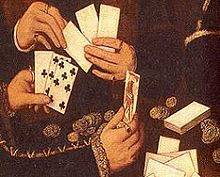Gilet (card game)
 |
|
| Origin | Italy |
|---|---|
| Alternative names | Gile |
| Family | Matching |
| Players | 2-4 |
| Skills required | Chance |
| Cards | 32 |
| Deck | Italian |
| Play | Clockwise |
| Playing time | 20 min. |
| Random chance | Medium |
| Related games | |
| Primero, Brelan | |
Gilet, also Gile, Gillet, is a 16th-century Italian gambling card game which probably antedates the game of Primero. Rabelais, in 1534, gives it pride of place in his list of games played by Gargantua, and Cardano, in 1564, describes it as Geleus, from the word Geleo, meaning "I have it".
One of the Italian versions of the name is apparently Gilè. The Manuale dei Giuochi, published in Trieste in 1593 lists a series of games played in Italy at the time, and among them the game of Gilet. In John Florio's 1611 dictionary it is explained that the game of Gilet was "like our poste and paire", being "Gé" (spelled J'ai), the word for "Pair", which is one of the announcements in the French version.
The name Gilet changed to Brelan in the time of Charles IX (1550–74), The Gilet of 18th century France was a three-card game of two deals, the first for a fixed stake won by the best pair or triplet, the second vied for in respect of the best-held flush-point. It first appeared in the Académie Universelle des Jeux in 1718, although its earlier references date of 1610 and 1640.
The Spanish variant is described by Barnes as "Giley", who says it was much played at horse fairs, and hence, by association, a gypsy game. It was played by four or more players who were dealt four cards each from a 28-card pack and a showdown was won by the best flush-point. With Ace worth 11, courts, treys, and deuces 10 each, and Seven worth 7, so a four-flush would be worth 37-41 points, a three-flush 27-30, and so on. Not dissimilar is Golfo, a game of Basque origin, declared by Barnes to be the king of gambling games and played also as Goffo in Italy and Gofo in Uruguay.
The game of Gilet is played by four players, each of whom play for themselves in the long run. A Piquet deck of 32 cards is used, 7 to A. The aces are higher than the king, which is higher than the queen, which is higher than the jack and so on.
After examining their cards, each contributes with two counters, worth as much as it is agreed by the players, to a common pot in the middle of the table. The dealer then gives three cards to each of the players, one after the other.
Any of the two pots in the middle of the table is entitled for the Gé, or Pair. It is possible for the players to bet on pairs, and that player who has the highest pair draws the money previously deposited in the pot and also the betting from the other players, unless one or more have a tricon, the highest combination of cards, that is, three aces, three kings, three queens and so on.
...
Wikipedia
